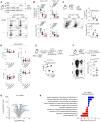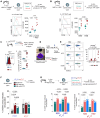Aryl Hydrocarbon Receptor Activation Promotes Effector CD4+ T Cell Homeostasis and Restrains Salt-Sensitive Hypertension
- PMID: 39779302
- PMCID: PMC11931625
- DOI: 10.1093/function/zqaf001
Aryl Hydrocarbon Receptor Activation Promotes Effector CD4+ T Cell Homeostasis and Restrains Salt-Sensitive Hypertension
Abstract
Excess dietary salt and salt-sensitivity contribute to cardiovascular disease. Distinct T cell phenotypic responses to high salt and hypertension, as well as influences from environmental cues, are not well understood. The aryl hydrocarbon receptor (AhR) is activated by dietary ligands, promoting T cell and systemic homeostasis. We hypothesized that activating AhR supports CD4+ homeostatic functions, such as cytokine production and mobilization, in response to high salt intake while mitigating salt-sensitive hypertension. In the intestinal mucosa, we demonstrate that a high-salt diet (HSD) is a key driving factor, independent of hypertension, in diminishing interleukin 17A (IL-17A) production by CD4+ T (Th17) cells without disrupting circulating cytokines associated with Th17 function. Previous studies suggest that hypertensive patients and individuals on a HSD are deficient in AhR ligands or agonistic metabolites. We found that activating AhR augments Th17 cells during experimental salt-sensitive hypertension. Further, we demonstrate that activating AhR in vitro contributes to sustaining Th17 cells in the setting of excess salt. Using photoconvertible Kikume Green-Red mice, we also revealed that HSD drives CD4+ T cell mobilization. Next, we found that excess salt augments T cell mobilization markers, validating HSD-driven T cell migration. Also, we found that activating AhR mitigates HSD-induced T cell migration markers. Using telemetry in a model of experimental salt-sensitivity, we found that activating AhR prevents the development of salt-sensitive hypertension. Collectively, stimulating AhR through dietary ligands facilitates immunologic and systemic functions amid excess salt intake and restrains the development of salt-sensitive hypertension.
Keywords: Th17; aryl hydrocarbon receptor; blood pressure; high-salt diet; salt-sensitive hypertension.
© The Author(s) 2025. Published by Oxford University Press on behalf of American Physiological Society.
Conflict of interest statement
DMP holds the position of editor-in-chief of
Figures





References
MeSH terms
Substances
Grants and funding
LinkOut - more resources
Full Text Sources
Medical
Research Materials

